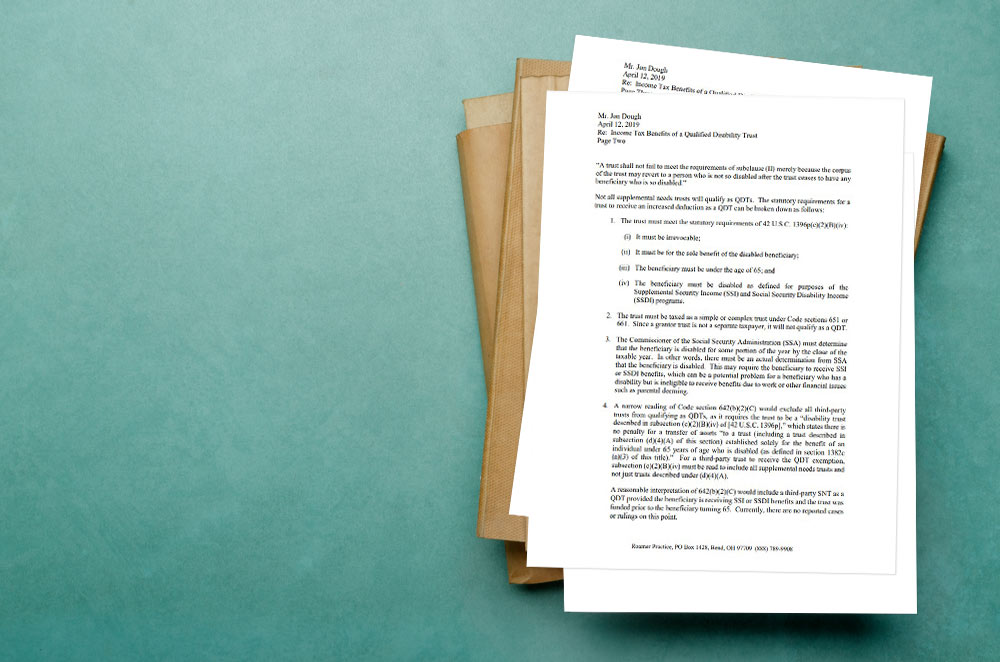
The legal authority to create a Qualified Disability Trust (QDisT) falls under §642(b)(2)(C) of the Internal Revenue Code. To qualify as a QDisT, the trust must meet the following criteria:
- A QDisT must be irrevocable.
- All beneficiaries must be disabled and receive Supplemental Security Income or Social Security Disability Income benefits. There can be more than one beneficiary, but all beneficiaries must be disabled. (According to IRC 642(b)(2)(C)(ii), a trust can still qualify as a QDisT if the corpus of the trust transfers to someone who is not disabled after all disabled beneficiaries are deceased.)
- A QDisT cannot be a grantor trust; the trust must be the taxpaying entity.
- The trust must be established for the benefit of disabled individuals 65 years of age or younger. (The QDisT does not cease to be a QDisT after the beneficiary turns 65, but it must be established beforehand.)
Benefits of a QDisT
At its core, a QDisT is an irrevocable trust that allows the beneficiary to benefit from trust funds while still allowing the beneficiary to maintain public-benefits eligibility. The main benefit of a QDisT over other trusts used for this purpose is taxation. Under IRC §642(b)(2)(C), a QDisT is allowed the same exemption as an individual when filing their tax return. The Tax Cuts and Jobs Act (TCJA), which became effective January 1, 2019, eliminated personal exemptions. However, it also stated that in any year in which there isn’t a personal exemption, there’s a certain amount for a QDisT exemption. In 2022, this figure is $4,450. Compare this $4,450 exemption to the $100 exemption afforded to simple trusts, and you can see how the savings can add up.
Another tax benefit of the QDisT is that the income of this particular type of trust is not subject to the Kiddie Tax, in accordance with IRS §642(b)(2)(C)(ii). The Kiddie Tax is a tax on the unearned income of a child. (Under certain circumstances, an individual can be considered a child until 24 years of age.) The Kiddie Tax came to fruition when the Internal Revenue Service realized some wealthier taxpayers were diverting income to their children to obtain a much lower tax bracket. In response, the IRS came up with the Kiddie Tax and stated that any unearned income for folks under a certain age and meeting certain criteria would be taxed at their parents’ bracket. The TCJA made the Kiddie Tax even harsher and ruled that the Kiddie Tax rate would not be at the parents’ tax rate, but at the higher tax rate of Trusts and Estates.
What are the tax filing requirements of a QDisT?
As with all non-grantor trusts, the trust will be responsible for filing a tax return, Form 1041, under its own Employer Identification Number (EIN). Any distributions to the beneficiary will be taxed on the beneficiary’s personal Form 1040 tax return.
For example, let’s say Bob is an independent Trustee of Lucy’s QDisT. The QDisT has a stock portfolio worth $500,000, which generates $50,000 in taxable income. During the tax year, Bob paid for Lucy’s vacation which cost $5,000. Bob also used trust funds to pay $5,000 for books, tutoring, and extracurricular activities. Bob took a reasonable compensation of $2,500 for the year.
Bob causes a Form 1041 to be filed for the trust, reporting the $50,000 income. As discussed above, there will be a $4,450 exemption. Bob’s $2,500 in fees will be deducted as an administrative expense, and Lucy’s $10,000 in distributions will be deducted. The trust will have a taxable income of $33,200. The QDisT will send a K-1 to Lucy showing her distribution, and she will be responsible for reporting that $10,000 distribution on her personal Form 1040 tax return.
Conclusion
A QDisT can be a powerful tool when planning for a disabled individual. Each attorney must do a case-by-case analysis to determine if a QDisT is the best planning device for their client. To know if a QDisT is right for a client, it’s important to analyze the facts of the case, including whether the client qualifies for a QDisT under statutory rules, the costs to maintain the QDisT, tax considerations, and more. Thankfully, the QDisT is one formidable tool when planning for a disabled person and can offer some great benefits.



